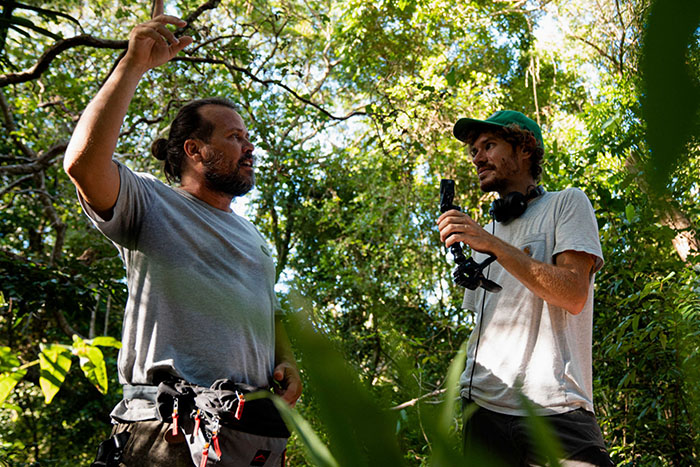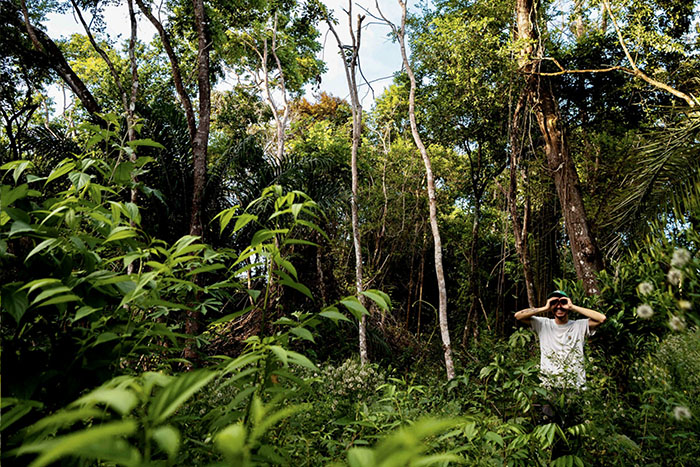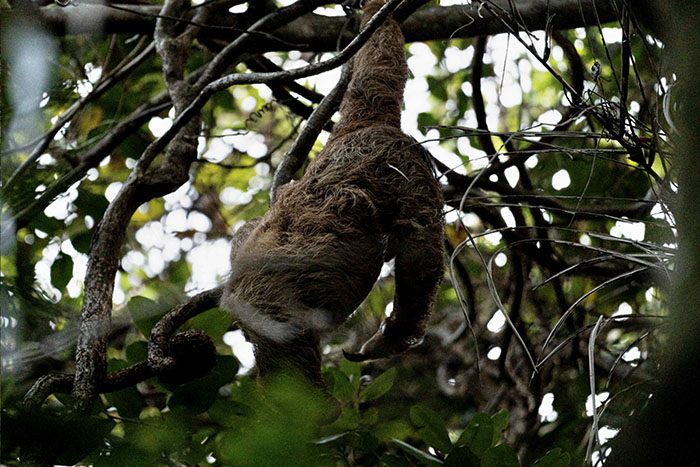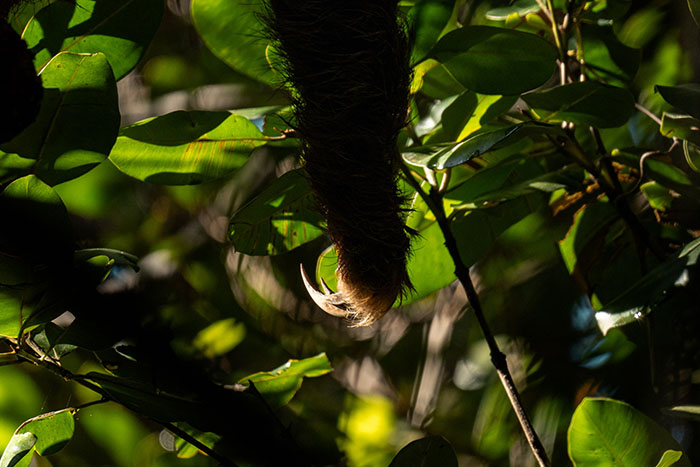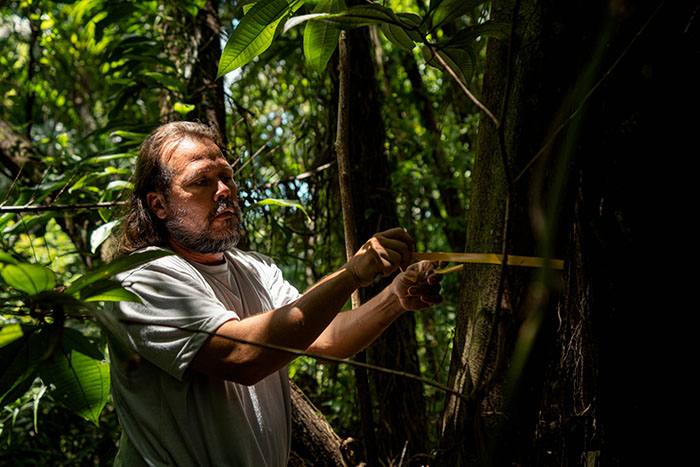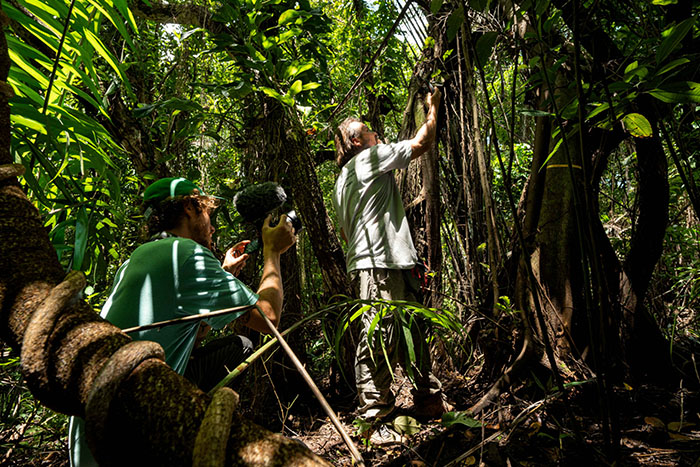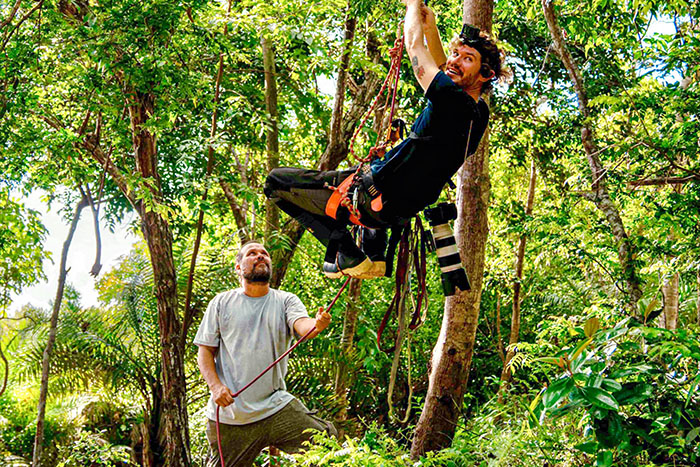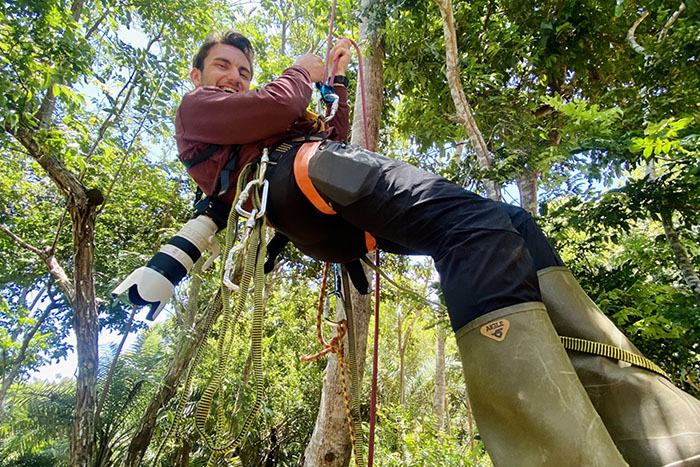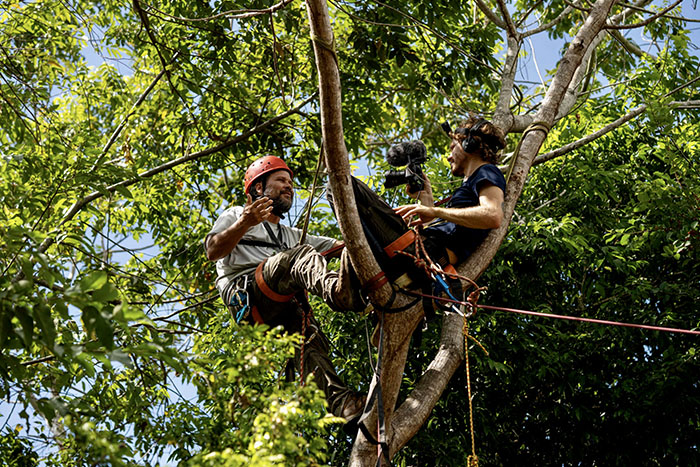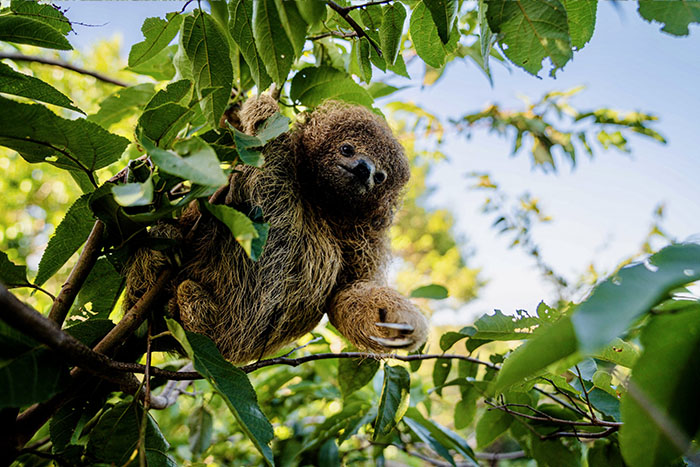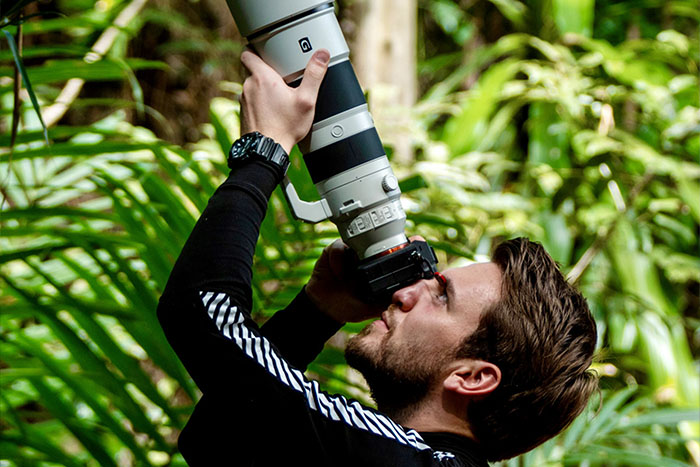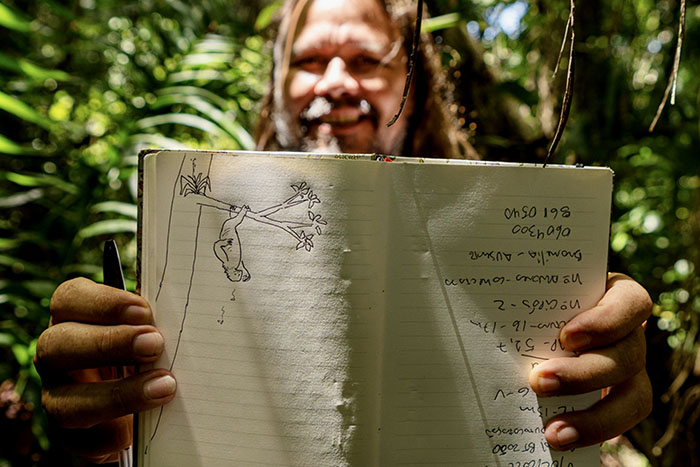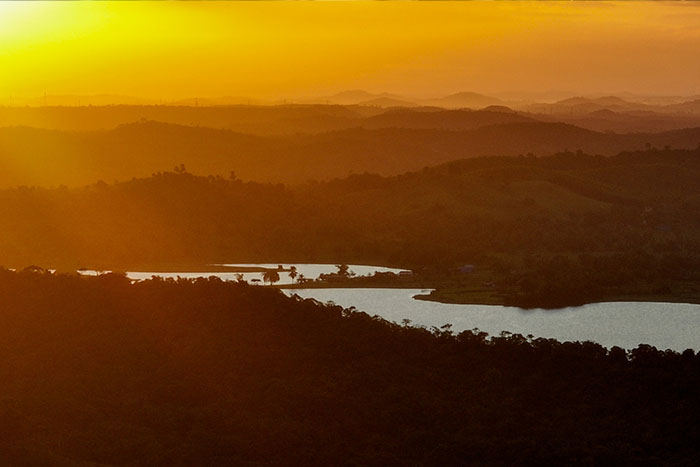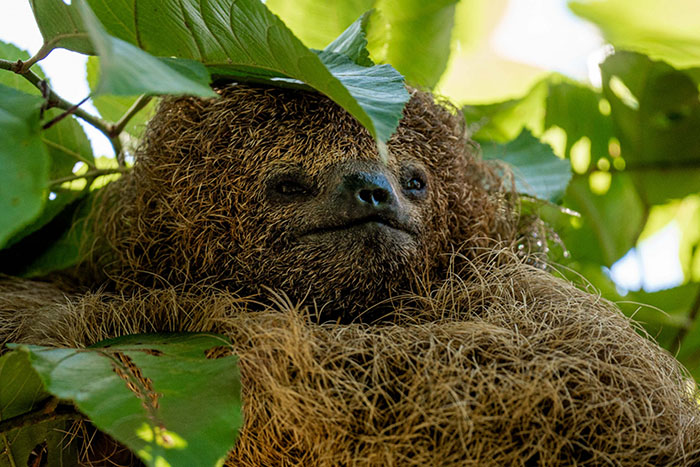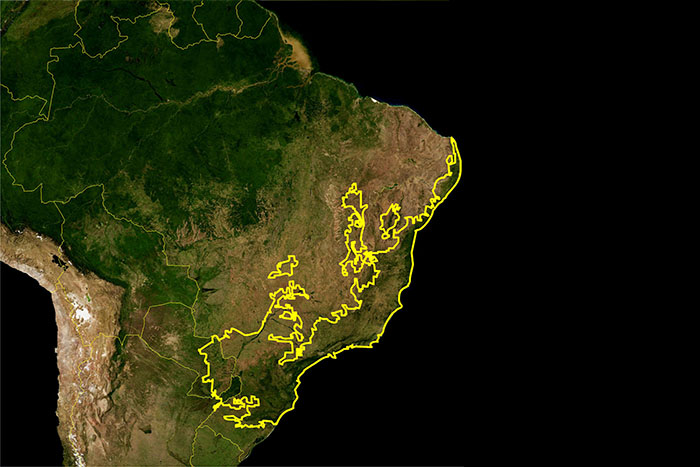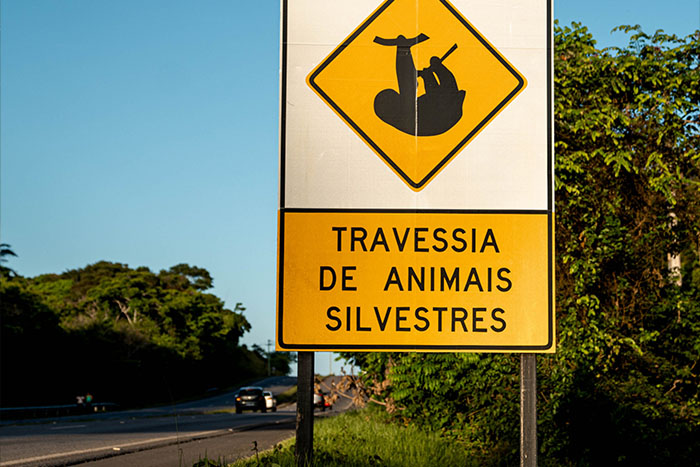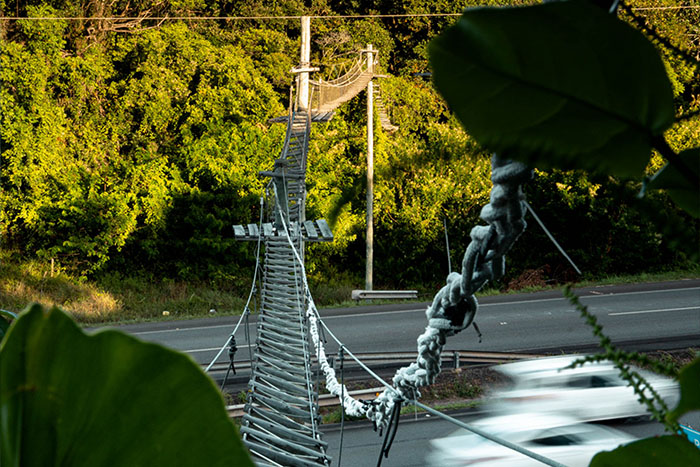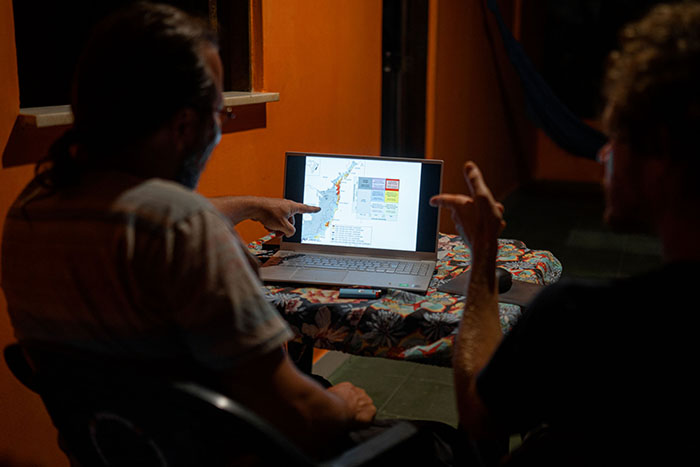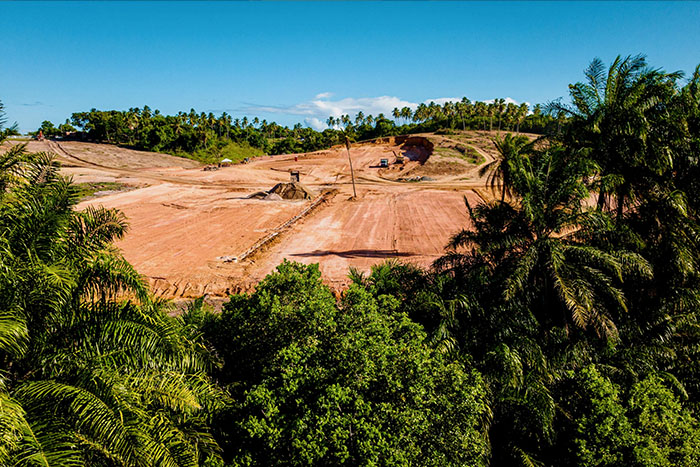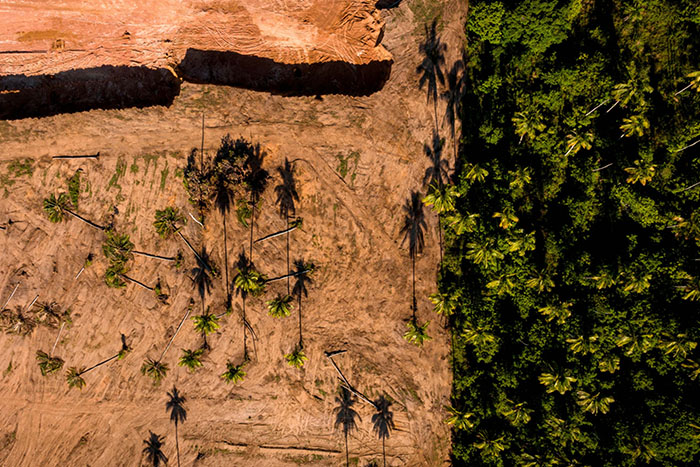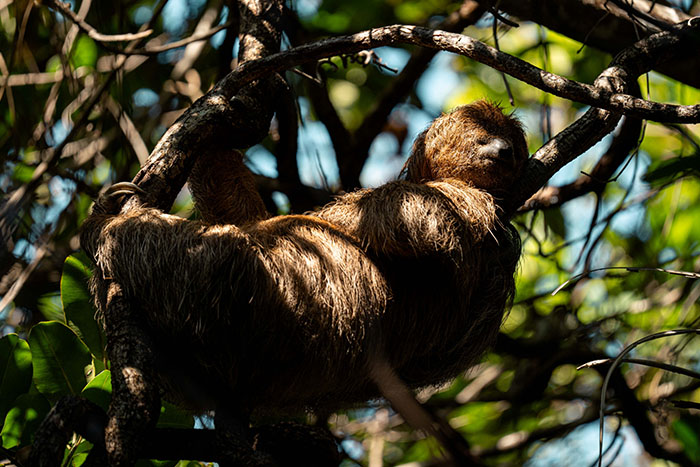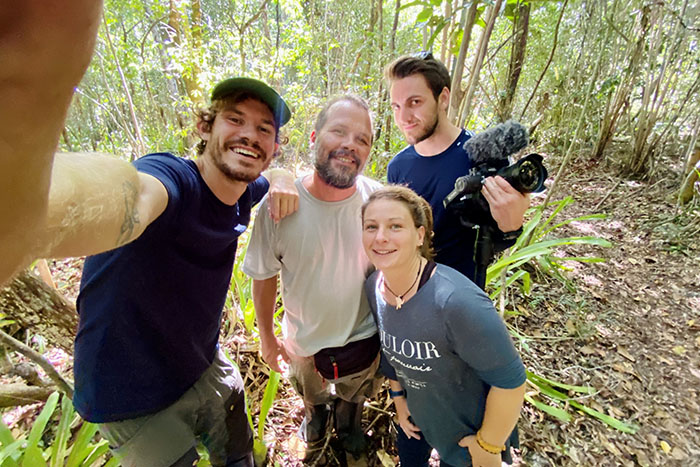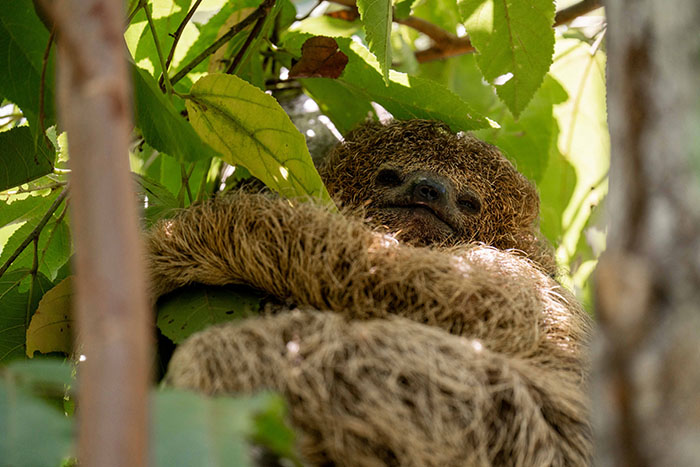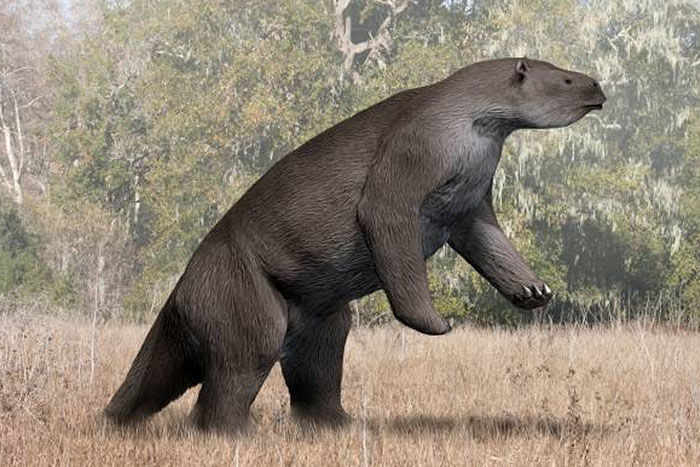Biodiversity Evolution⎢Brazil⎢2022
The sloth
facing deforestation
In partnership with Universidade Estadual de Santa Cruz

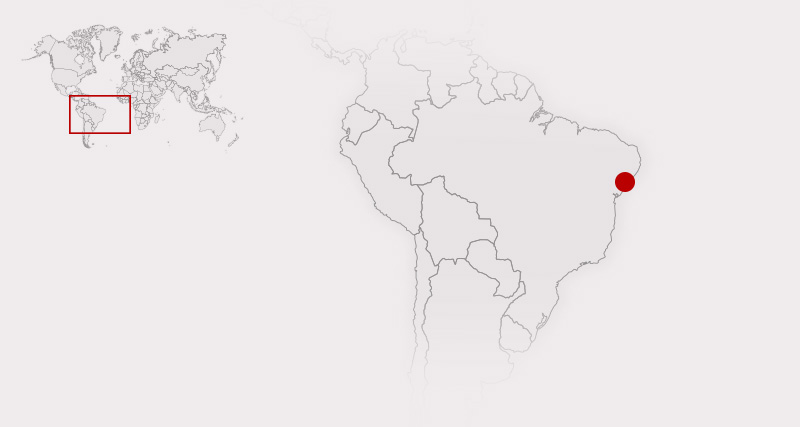
The maned sloth (Bradypus torquatus), a 50-centimeter-long mammal, resides among the treetops in the Brazilian Atlantic Rainforest. In his travelogues, Darwin frequently references sloths, particularly the extinct giant sloth (Megatherium americana), for which he was the first to bring bones to Europe.
Darwin extensively pondered the origins of the Megatherium’s demise, though he hesitated to definitively link it to human activity. Now, two centuries later, Bradypus torquatus, a direct evolutionary descendant of the giant sloth, faces the same perilous destiny as its ancestor. To delve deeper into this matter, we joined scientist Gaston Giné from the University of Santa Cruz on a weeks-long exploration deep within the heart of the forest.
Days of Exploration
Associated Researcher
Photographs Taken
Hours of Footage

1832
South America is characterized by possessing many peculiar gnawers, a family of monkeys, the llama, peccari, tapir, opossums, and, especially, several genera of Edentata, the order which includes the sloths, ant-eaters, and armadillos.
At Punta Alta we have a section of one of these later-formed little plains, which is highly interesting from the number and extraordinary character of the remains of gigantic land-animals embedded in it. […] First, parts of three heads and other bones of the Megatherium, the huge dimensions of which are expressed by its name.
– Charles Darwin, Voyage of the Beagle, 1832

2022
Deforestation, undertaken for urban expansion and agriculture, has decimated the Atlantic rainforest, shrinking it by a staggering 90%. This poses a grave threat to Bradypus torquatus, as it faces extensive habitat loss and fragmentation.
The demise of the Megatherium resulted from human hunting and habitat fragmentation caused by climatic conditions during the last ice age. There are concerns that the maned sloth may suffer a similar fate to its ancestor unless conservation efforts, including robust reforestation initiatives, are significantly intensified.

1832
South America is characterized by possessing many peculiar gnawers, a family of monkeys, the llama, peccari, tapir, opossums, and, especially, several genera of Edentata, the order which includes the sloths, ant-eaters, and armadillos.
At Punta Alta we have a section of one of these later-formed little plains, which is highly interesting from the number and extraordinary character of the remains of gigantic land-animals embedded in it. […] First, parts of three heads and other bones of the Megatherium, the huge dimensions of which are expressed by its name.
– Charles Darwin, Voyage of the Beagle, 1832

2022
Deforestation, undertaken for urban expansion and agriculture, has decimated the Atlantic rainforest, shrinking it by a staggering 90%. This poses a grave threat to Bradypus torquatus, as it faces extensive habitat loss and fragmentation.
The demise of the Megatherium resulted from human hunting and habitat fragmentation caused by climatic conditions during the last ice age. There are concerns that the maned sloth may suffer a similar fate to its ancestor unless conservation efforts, including robust reforestation initiatives, are significantly intensified.
First encounter in Sapiranga
Finally, we are in the forest! After months of preparation, we have finally arrived in the field to document the sloths. This morning we left Salvador for the town of Praia do Forte, an hour’s drive north.
We met Gaston Giné, a scientist specializing in sloths and porcupines. He took us to the Sapiranga Reserve, a protected portion of forest that is known to be home to sloths.
It’s a beautiful place! After spending so much time at sea, it was amazing to walk through a forest teeming with life. The noise is deafening! Cicadas, frogs, birds, the cumulative sounds of all these animals produce a tremendous cacophony – the music of life. When he arrived in Brazil, Darwin was also impressed by the sounds of the forest.
Our goal today was to find a sloth in the trees. After several hours of searching, we still hadn’t found anything. Night was beginning to fall, and we were ready to return to our rental house to resume the search the next day.
And that’s when we saw it. Perched in a tree, about ten meters high: a sloth. Gaston thinks it’s a female. She scratches her hair with her big claws, after a quiet day spent eating leaves in the trees. We are so happy!
As it is almost dark, we decide to come back to see it tomorrow morning with scientific equipment that will be used to study it more closely.
Gaston’s research
This morning, with Gaston, Cécile and Maxime (the photographer who has just joined us), we had the pleasure of seeing that the sloth hadn’t moved! The opportunity for Gaston to record several scientific data to better understand the functioning of the species.
First, he noted the characteristics of the tree our new friend was on. Then, he noted the GPS position, and recorded in his notebook the actions of the sloth: movement, arm movements, position in the tree, and so on.
Gaston’s eyes sparkle: I see that he is passionate about his work. For him, being in the field in contact with Nature is the definition of happiness. No doubt Darwin would agree with him!
Climbing trees
Today is climbing! Gaston wants to make finer observations of the sloths, and he also wants to get leaf samples from the canopy (the upper part of the forest). So, no choice, you have to equip yourself: a harness, a rope, a few carabiners… and let’s go for a bit of sport!
Sloths are animals that move very little and essentially stay at the very top of their tree. They eat the leaves, and it is their only source of food. They do not even drink water: they hydrate themselves thanks to the water contained in the foliage which they taste.
About once a week they come down from their tree to poop. It’s a risky trip, as their slowness makes them easy prey for predators. But then, why not poop from the heights? So the sloth would be an example of politeness? In fact, scientists don’t know that yet.
I was lucky enough to climb a tree. It was great! This allowed me, as well as Maxime, to make beautiful images. We were even… a little too close, when you see the photo. We’re preparing beautiful images of a whole sloth for you very soon.
Darwin the sloth
Say hello to Darwin, the sloth. He’s a juvenile (i.e. a youngster) about 12 months old. 2 months ago, he left his mother’s arms to live his life. However, it cannot be considered completely adult: it is only at 3 years old that it is perfectly autonomous. Until then, his mother stays nearby (Darwin’s mother was also 4 trees away!).
Sloths are solitary animals that lead curious lives. They only eat leaves, and their metabolism is extremely slow. They thus move at the speed of a snail. Or is it the snail that moves at the speed of the sloth?
It’s very moving to be so close to a wild animal. Of course, our scientist Gaston was always with us and he made sure that we didn’t disturb our dear Darwin. It was Gaston who named it after our famous naturalist! He even made a drawing of it, which you can see in one of the photos.
Surely you have many questions about the sloth. And you are right: there is a lot to be said for it. What is his connection to Darwin? How do they live? How do they adapt to forest changes and climate change? Why should we care about sloths? I questioned Gaston a lot on this subject: his answers, I will transcribe them to you in the coming days.
The Atlantic Tropical Forest
Where do sloths live? Well, it all depends on the species you’re talking about! Indeed, there is not one, but four species of sloth. Among them is the maned sloth (Bradypus torquatus), the species to which Darwin belongs (the individual we photographed yesterday).
Maned sloths are only found in the Mata Atlanticâ, the Atlantic rainforest that is found in Brazil and which we find ourselves in right now. Look at the map of this forest, you will immediately understand why it is called Mata Atlanticâ. It is indeed all along the Brazilian coast (and therefore the Atlantic Ocean), between the city of Natal, in the North, and up to the border with Uruguay, in the South.
It is a forest probably less known than the Amazon because over the centuries it has lost a significant part of its initial area. Today, only about 10% remains! In question, the intensive use of the forest by man, and in particular the development of cities and agriculture.
However, the forest still harbors an extremely rich biodiversity! There are 20,000 species of plants, and more than 2,000 species of animals, not counting insects. The maned sloth is one of them. Its survival therefore totally depends on man’s ability to preserve this Mata Atlanticâ, his only home.
A vulnerable species
What do lazy people do with their days? It’s a question that seems very simple, but whose answer is complex. It is Gaston’s job to answer them! For 90% of their life, sloths do not move. They use their powerful muscles to cling to the trees on which they feed. Look on the photo: we see a female sloth suspended by her feet from her branch.
As I told you in a previous message, sloths only come down from their tree once a week to poop. But they also happen to move from one tree to another using branches, or more rarely by crawling on the ground at a speed of 3 meters per minute. To realize this speed, I invite you to bring a stopwatch and cover in 60 seconds the distance you usually cover in 4 or 5 steps. You will see, you will be bored!
To understand the (rare) movements of sloths, Gaston sometimes uses “GPS binders”. He thus installs on the backs of certain individuals small bags containing a GPS which records the position of the animal several times a day. The recording lasts several months, at the end of which Gaston centralizes all the information collected on an animated map.
He discovers that most sloths have a small territory, about half a square kilometer. In fact, since they eat the leaves of trees and only reproduce once every two years, they have little reason to move. They also have a very slow metabolism (metabolism is the way the body works), and can also vary their body temperature (between 25 and 34°C) to adapt to their environment.
These characteristics make the sloth very vulnerable to landscape changes and deforestation. It is indeed very difficult to escape from a forest that is being abused when you are moving at 3 meters per minute! Human constructions such as roads or oil pipelines that cross the forest also make their life complicated, because they block their way when they seek to reproduce, or quite simply to change trees to feed themselves. This is called forest fragmentation.
Gaston tries to help the sloths by building bridges over the roads. Thus, he hopes to help wild animals cross these artificial borders. You can see one in one of the photos! Obviously, nothing replaces a healthy and unfragmented forest, but these kinds of initiatives are positive all the same.
Deforestation
What do sloths dread? As we study the sloth from every angle, I notice that we often hear human-made sounds while we’re in the middle of the forest. Music echoing in the distance, the passing of a car, the sound of bulldozers. They are sometimes heard very distinctly, and these noises remind us of the threats to sloths. The sloth has always shared its habitat with many animals.
The presence of man in the Mata Atlântica is not new: Homo sapiens has populated South America for more than 10,000 years. But our remarkable ingenuity has recently led us to have a terrible impact on ecosystems. Thus, in the area of Praia do Forte where we find ourselves today, there are many construction sites of condominio (residential areas) which are gradually grabbing pieces of forest.
Sloths are slow: you already knew that. In the previous post, I recalled that they can move at a rate of 3 meters per minute. Naturally, they are no match for the huge bulldozers digging into the Mata Atlântica to lay the foundations for future homes. Deforestation and habitat fragmentation are the biggest threats to sloths.
The future of the maned sloth
Discovering the forest with Gaston is a real privilege. His passion for sloths is contagious: the whole team now knows this animal much better. And you too, I hope! We loved following him in the forest and accompanying him in his work as a scientist.
What did we learn with Gaston?
To answer this question, let’s go back to the link between Darwin and the sloth. In 1832, Darwin unearthed a fossil of a giant sloth, named Megatherium americana. This animal was 10 times the size of a current sloth, and its weight could reach 4 tons. Darwin was fascinated by the resemblances between this extinct animal and certain living species today, such as the sloth, the anteater or the armadillo. This observation will lead him to the idea of a common ancestor, one of the pillars of the theory of evolution.
The Megatherium disappeared from the surface of the Earth around 10,000 years ago. This species became extinct for two reasons. The first is climate change which, at the time, led to a natural fragmentation of its habitat. The second is that the giant sloth was hunted by humans.
So, is the current sloth in danger of disappearing, like its ancestor the Megatherium? We have seen, in previous posts, that it too is experiencing problems related to fragmentation and the loss of its habitat.
According to Gaston, the changes that man produces in the forest are so rapid that the sloth will have a hard time adapting to them. That said, unlike humans 10,000 years ago, we have many tools to understand sloths and find solutions to protect them. For example, Gaston has created a map that indicates which parts of the Mata Atlântica must be protected in priority, and how.
The tools for preserving the environment exist: we must now use them.



Donate
Help us spread the word about biodiversity by supporting our Patreon!
Social Networks
Follow Captain Darwin on Social Networks to follow our adventures!
Send an email
A question? Something to say? A word of encouragement? Send us an email!
© Captain Darwin 2023 - 1 rue des Senneurs - 29 900 Concarneau - FRANCE

